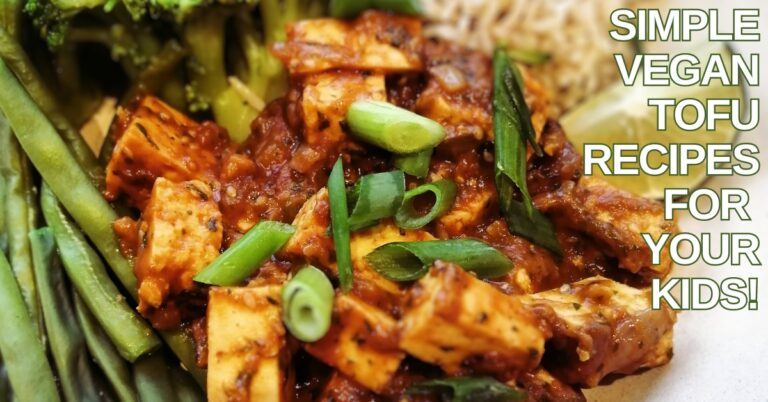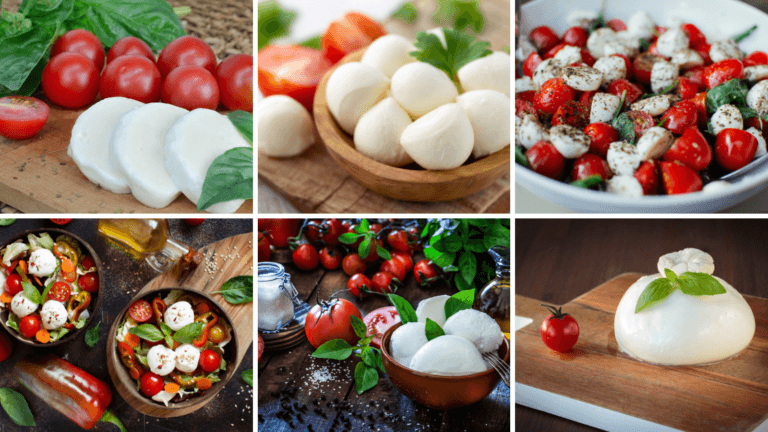Authentic Vegan Recipes Of India
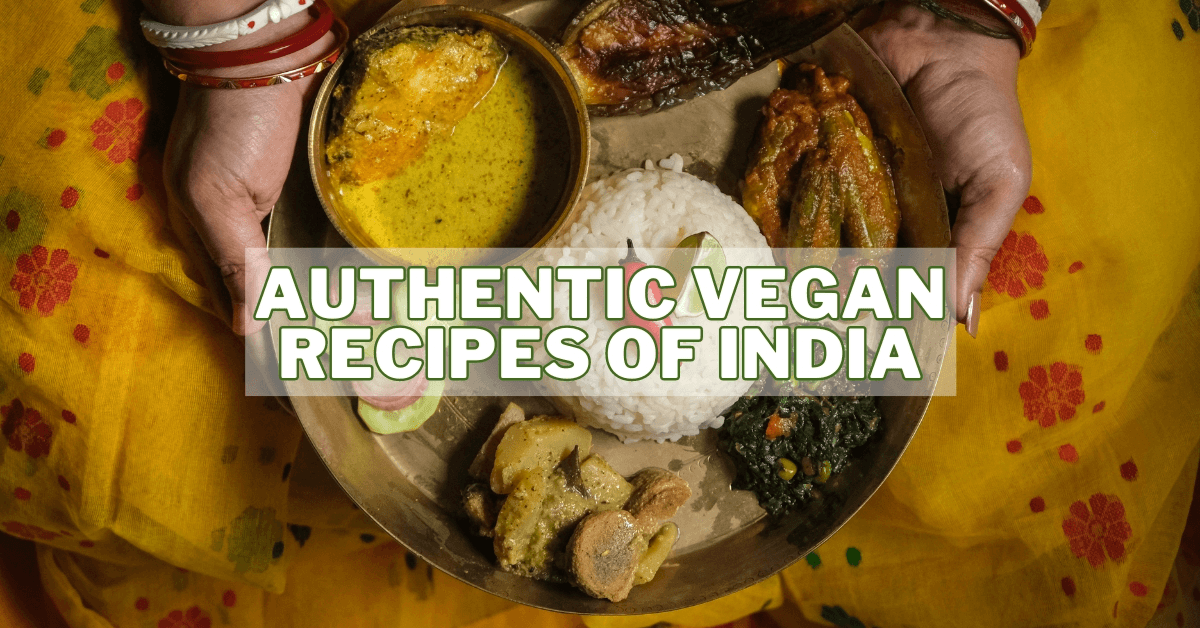
Authentic Vegan Recipes of India
Are you looking to infuse your kitchen with the vibrant flavours of India while staying true to your vegan lifestyle? Look no further than “Vegan Recipes of India”!
With 5 delectable recipes curated to tantalize your taste buds, this collection offers a delightful fusion of traditional Indian cuisine and plant-based goodness.
From aromatic curries to crispy pakoras, each dish is thoughtfully crafted to showcase the rich tapestry of flavours that Indian cooking is known for—all without animal products.
How To Veganize Indian Recipes
To make Indian recipes vegan, you can switch out animal-based ingredients for plant-based alternatives.
Instead of dairy milk, try almond, soy, or coconut milk, and opt for vegan yogurt or cream—swap vegan butter for coconut oil or vegan margarine. Use tofu, tempeh, or legumes like chickpeas and lentils for protein instead of meat.
Remember to spice things up with herbs, spices, and aromatics to keep the flavours authentic. Get creative with traditional Indian cooking techniques and ingredients to whip up delicious vegan dishes that capture the essence of Indian cuisine while being mindful of ethical and dietary choices.
Indian Vegan Culture
Indian vegan culture is a dynamic and growing movement that embraces the principles of compassion, sustainability, and health.
Rooted in the ancient traditions of vegetarianism, veganism in India extends this philosophy to exclude all animal products, including dairy and honey.
Veganism aligns with the concept of ahimsa (non-violence), which is central to Indian spiritual and ethical beliefs.
With a rich tapestry of plant-based ingredients and centuries-old culinary traditions, Indian cuisine offers a treasure trove of vegan-friendly dishes, from fragrant curries to savoury snacks and sweet treats.
The rise of veganism in India reflects a broader global awareness of ethical consumption and environmental stewardship as more people embrace plant-based living to benefit animals, the planet, and personal well-being.
Authentic Vegan Recipes Of India
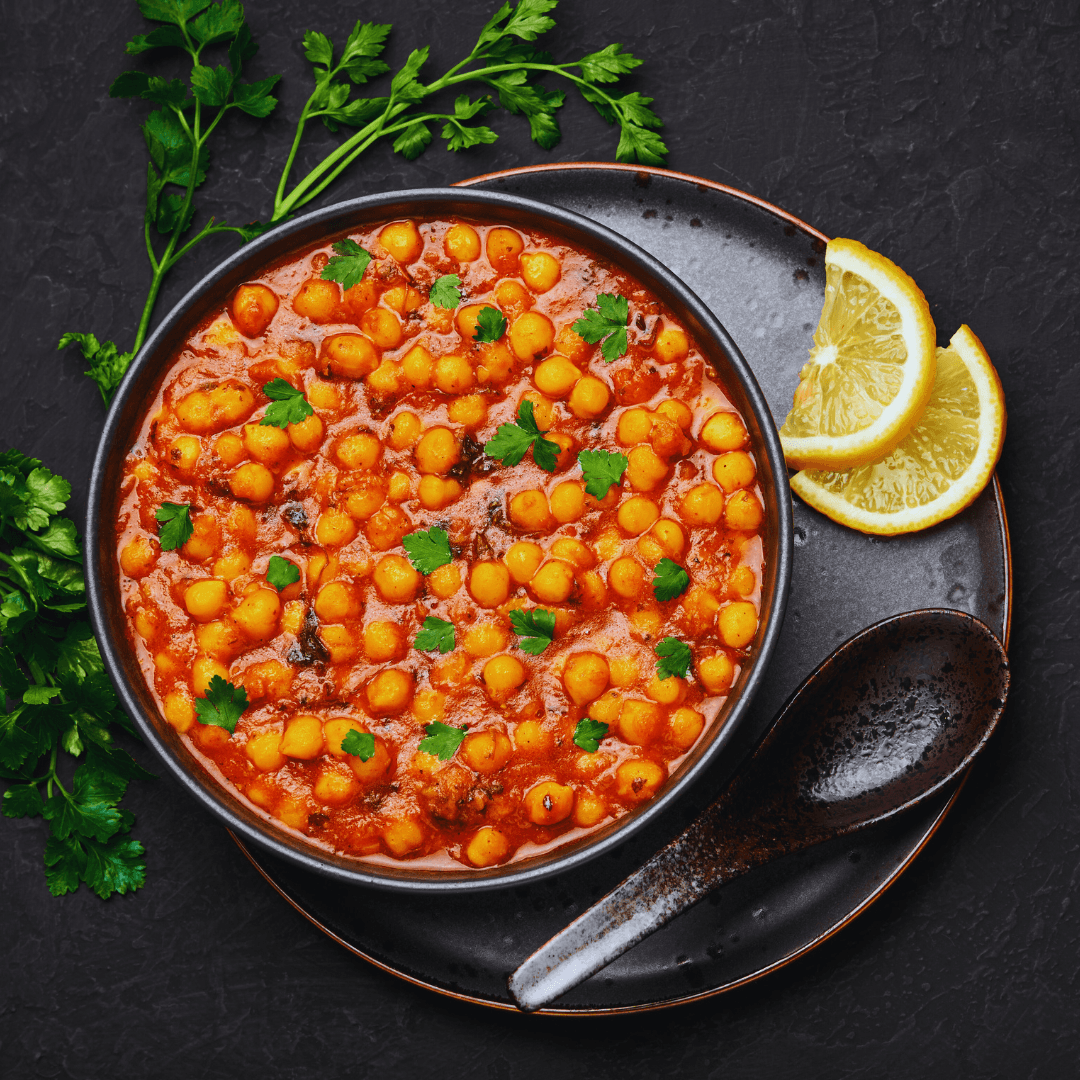
1. Vegan Chana Masala
Chana Masala is a quintessential North Indian dish featuring tender chickpeas simmered in a rich, aromatic tomato-based gravy infused with spices. This hearty and flavourful vegan dish is perfect for a satisfying meal any day of the week.
Prep time: 15 minutes | Cook time: 30 minutes | Total time: 45 minutes | Servings: 4
Ingredients
- Cooked chickpeas: 2 cups or 2 cans, drained and rinsed
- Onion: 1 large, finely chopped
- Tomatoes: 2 medium, finely chopped
- Garlic: 3 cloves, minced
- Ginger: 1-inch piece, grated
- Green chillies: 2, finely chopped (modify to taste)
- Cumin seeds: 1 teaspoon
- Coriander powder: 1 teaspoon
- Turmeric powder: ½ teaspoon
- Garam masala: ½ teaspoon
- Sea salt to taste
- Fresh cilantro for garnish
- Oil: 2 tablespoons
- Water as needed
Method
- Fill a large pot or skillet with oil and heat it to medium. Add the cumin seeds to the pan to create a pleasant aroma and allow them to crackle.
- After adding the diced onions, sauté them for five to seven minutes or until they caramelize.
- Add minced garlic, chopped green chillies, and grated ginger. When the combination smells fragrant, sauté it for another two minutes.
- After adding them to the pan, Cook for 5 to 7 minutes or until the chopped tomatoes soften and break down.
- Add cooked chickpeas to the pan along with salt to taste. Stir to combine.
- Pour in water as needed to reach your desired consistency. Simmer the mixture gently on low heat.
- To let the flavours combine, cook the Chana Masala, uncovered, for ten to fifteen minutes.
- Taste and adjust seasoning if needed. Garnish with fresh cilantro leaves.
- Serve hot with rice, naan, or your favorite bread.
Nutrition Facts Of Vegan Chana Masala (per serving)
- Calories: 250 kcal
- Protein: 8g
- Fat: 10g
- Carbohydrates: 35g
- Fiber: 10g
- Sugar: 5g
Health Benefits Of Vegan Chana Masala
- Rich in plant-based protein and fiber, aiding satiety and promoting digestive health.
- Provides vital nutrients, including iron, folate, and magnesium, which support general health.
- Incorporates spices like turmeric and ginger, known for their anti-inflammatory and immune-boosting properties.
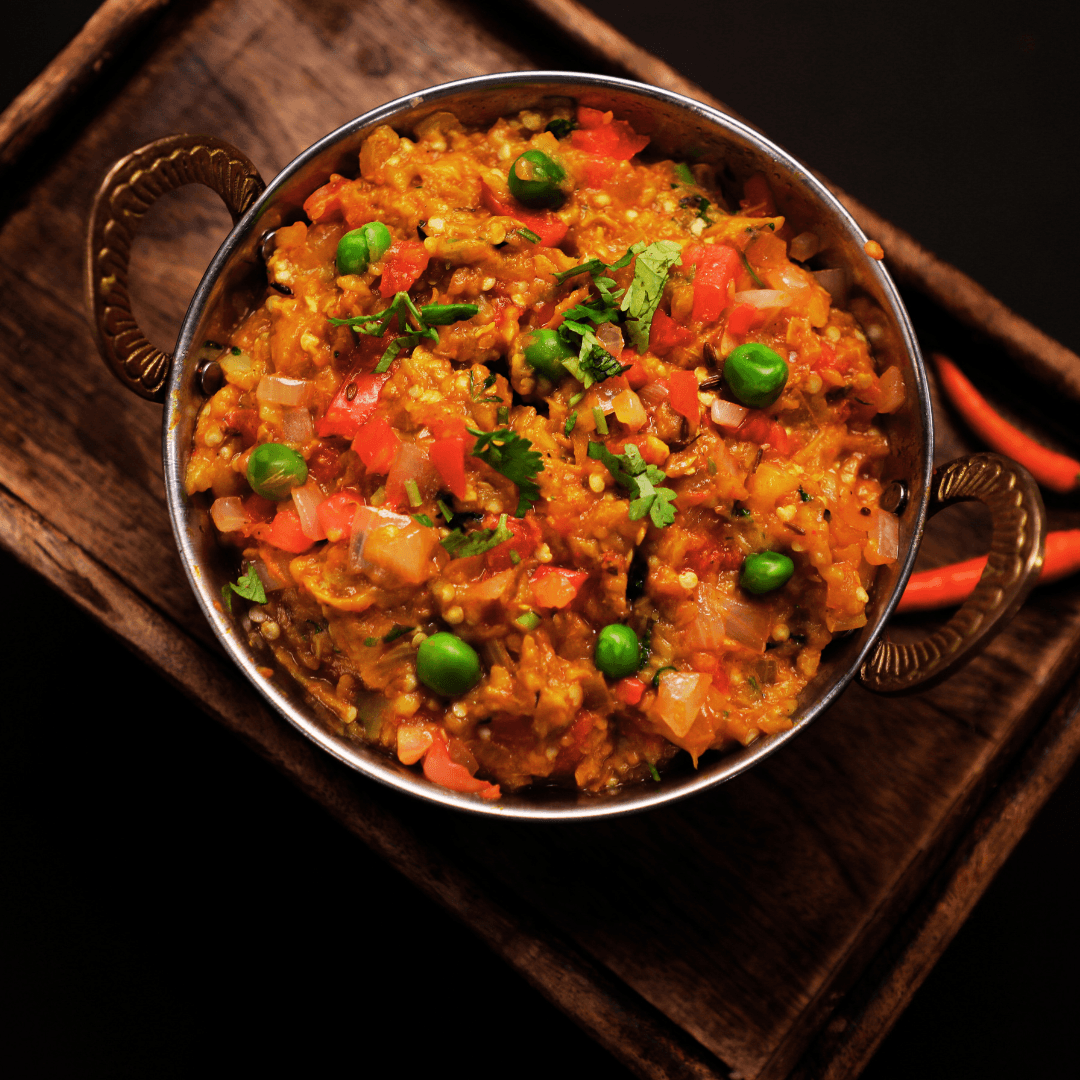
2. Vegan Baingan Bharta
Baingan Bharta is a classic Indian dish made with roasted eggplant, which is then mashed and cooked with onions, tomatoes, and aromatic spices.
This flavourful and smoky vegan dish is popular in North Indian cuisine. It is perfect for a comforting meal.
Prep time: 15 minutes | Cook time: 40 minutes | Total time: 55 minutes | Servings: 4
Ingredients
- Eggplant (baingan): 1 large
- Oil: 2 tablespoons
- Cumin seeds: 1 teaspoon
- Onion: 1 large, finely chopped
- Tomatoes: 2, finely chopped
- Garlic: 3 cloves, minced
- Ginger: 1-inch piece, grated
- Green chillies: 2 finely chopped (modify to taste)
- Coriander powder: 1 teaspoon
- Turmeric powder: ½ teaspoon
- Chilli powder (red): ½ teaspoon
- Sea salt to taste
- Fresh cilantro for garnish
Method
- Preheat the oven to 400°F (200°C). After being pricked many times with a fork, place the eggplant on a baking pan.
- When the skin is blackened and the meat is soft, roast in the oven for 30 to 40 minutes, flipping regularly.
- After roasting, the eggplant should be cooled from the oven. Remove the burnt skin and toss it aside. Mash the meat with a fork or potato masher until smooth, then set aside.
- Heat the oil in a large skillet or saucepan on medium heat. Add the cumin seeds and let them crackle to release their flavour.
- Stir in minced garlic, grated ginger, and chopped green chillies. Continue sautéing for an additional 2 minutes until the mixture becomes fragrant.
- Add chopped tomatoes to the pan and cook until they soften and break down, about 5-7 minutes.
- Add salt to taste, red chilli powder, turmeric, and coriander. Stir well and toast the spices for one to two minutes.
- Mix the mashed eggplant in the skillet well with the spice blend. Cook for five to seven more minutes, stirring now and then.
- Taste and adjust seasoning if needed. Garnish with fresh cilantro leaves.
- Serve the dish hot with your choice of roti, naan, or rice.
Nutrition Facts Of Vegan Baingan Bharta (per serving)
- Calories: 120 kcal
- Protein: 2g
- Fat: 7g
- Carbohydrates: 15g
- Fiber: 6g
- Sugar: 8g
Health Benefits Of Vegan Baingan Bharta
- Eggplant is low in calories and high in fiber, which helps with weight management and digestive health.
- It has nutrients, including potassium, manganese, and vitamin C, that boost the immune system and heart health.
- It incorporates garlic and ginger, known for their anti-inflammatory and immune-boosting properties.
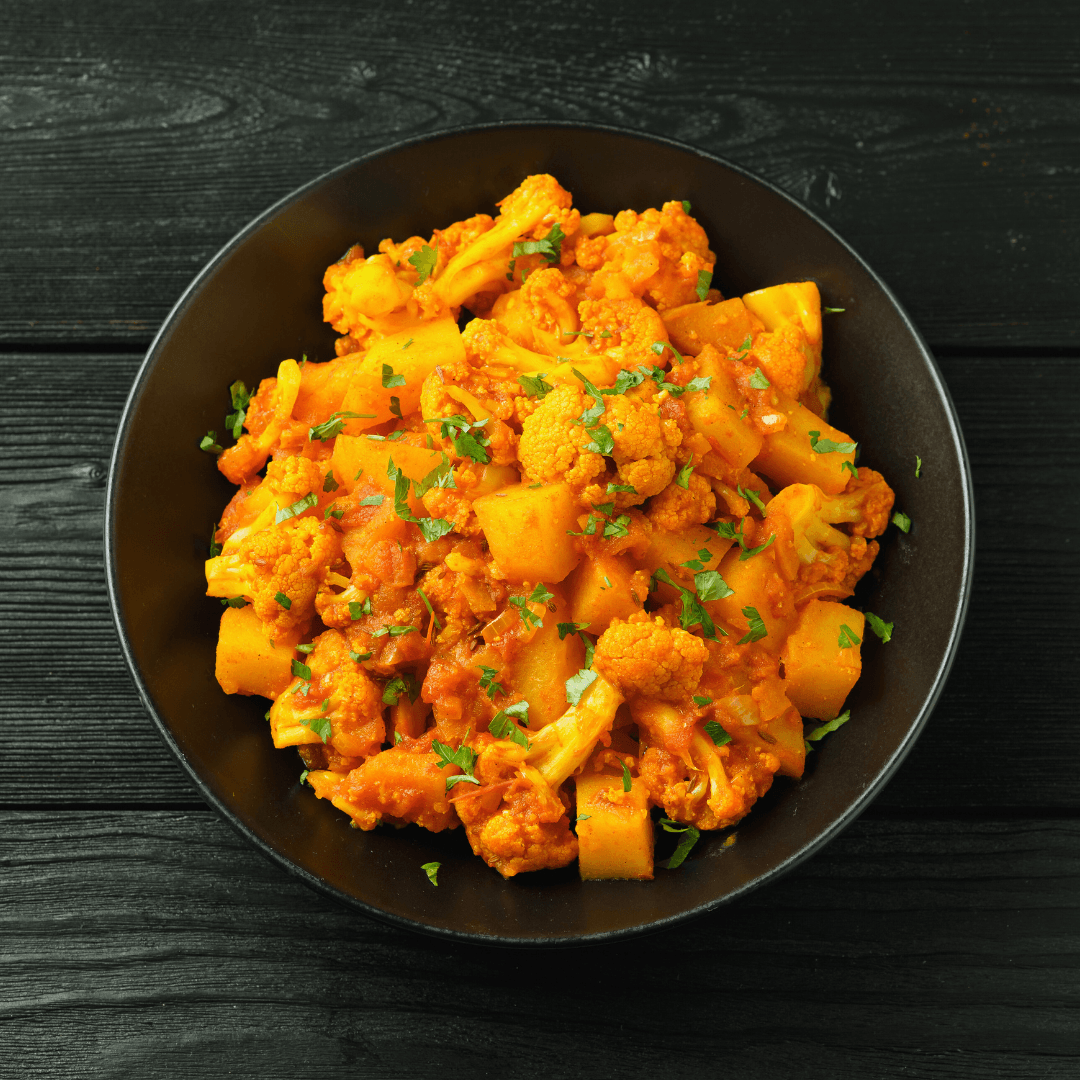
3. Vegan Aloo Gobi
Aloo Gobi is a classic Indian dish that translates to “potatoes and cauliflower” in English. It's a comforting and flavourful vegan dish made with tender potatoes, cauliflower florets, and aromatic spices.
Aloo Gobi is a staple in North Indian cuisine and is enjoyed as a side dish or main course with roti or rice.
Prep time: 15 minutes | Cook time: 30 minutes | Total time: 45 minutes | Servings: 4
Ingredients
- Oil: 2 tablespoons
- Cumin seeds: 1 teaspoon
- Potato: 1 large, peeled and cut into small cubes.
- Cauliflower: 1 small, cut into florets
- Onion: 1 large, finely chopped
- Tomatoes: 2, finely chopped
- Garlic: 3 cloves, minced
- Ginger: 1-inch piece, grated
- Green chillies: 2 finely chopped (modify to taste)
- Turmeric powder: 1 teaspoon
- Cumin powder: 1 teaspoon
- Coriander powder: 1 teaspoon
- Garam masala: ½ teaspoon
- Sea salt to taste
- Fresh cilantro for garnish
Method
- Heat the oil in a large pot or skillet over medium heat. Add the cumin seeds and let them crackle to release their flavour.
- Add the chopped potatoes to the skillet and cook, stirring, for 5 to 7 minutes or until golden brown.
- Add cauliflower florets to the pan and continue to sauté for another 5 minutes.
- Stir in chopped onions and cook until they turn translucent about 5 minutes.
- Add minced garlic, grated ginger, and chopped green chillies to the pan. Continue sautéing for an additional 2 minutes until the mixture becomes fragrant.
- Add chopped tomatoes to the pan and cook until they soften and break down, about 5-7 minutes.
- Sprinkle turmeric powder, cumin powder, coriander powder, garam masala, and salt over the vegetables. Mix well to coat evenly.
- Cover the pan and let the Aloo Gobi cook for 10-15 minutes, stirring occasionally, until the potatoes and cauliflower are tender.
- Once cooked, garnish with fresh cilantro leaves.
- Serve the dish hot with your choice of roti, naan, or rice.
Nutrition Facts Of Vegan Aloo Gobi (per serving)
- Calories: 150 kcal
- Protein: 4g
- Fat: 7g
- Carbohydrates: 20g
- Fiber: 5g
- Sugar: 5g
Health Benefits Of Vegan Aloo Gobi
- Potatoes are an excellent source of fiber, potassium, and vitamins C and B6, which support healthy hearts and facilitate digestion.
- Cauliflower is low in calories and fiber, vitamins C and K, and antioxidants, which support overall health and immunity.
- Aloo Gobi is cooked with anti-inflammatory spices like turmeric and ginger, offering potential benefits for joint health and reducing inflammation.

4. Vegetable Biryani
Vegetable Biryani is an aromatic and tasty rice dish with roots in the Indian subcontinent. It's made by cooking basmati rice with assorted vegetables, fragrant spices, and herbs.
This one-pot vegan meal is perfect for gatherings, special occasions, or a delicious weeknight dinner.
Prep time: 20 minutes | Cook time: 30 minutes | Total time: 50 minutes | Servings: 4
Ingredients
- Basmati rice: 1½ cups rinsed and soaked for 30 minutes
- Oil or vegan butter: 2 tablespoons
- Onion: 1 large, thinly sliced
- Tomatoes: 2, chopped
- Mixed vegetables (carrots, peas, bell peppers, etc.): 1 cup
- Vegan yogurt: ½ cup
- Ginger-garlic paste: 1 teaspoon
- Cumin seeds: 1 teaspoon
- Bay leaves: 2
- Whole cloves: 4-5
- Whole green cardamom pods: 4-5
- Cinnamon stick: 1
- Turmeric powder: ½ teaspoon
- Garam masala: 1 teaspoon
- Sea salt to taste
- Fresh cilantro for garnish
- Fried onions (optional)
Method
- Warm oil or vegan butter in a sizable pot over medium heat. Add cumin seeds, bay leaves, cloves, cardamom pods, and cinnamon sticks. Sauté for 1-2 minutes until fragrant.
- Add thinly sliced onions to the pot and cook until golden brown, about 8-10 minutes.
- Stir in ginger-garlic paste and cook for another 2 minutes until aromatic.
- Add chopped tomatoes to the pot and cook until they soften and break down, about 5-7 minutes.
- Mix in mixed vegetables and cook for 5 minutes until slightly tender.
- Stir in plain yogurt, turmeric powder, and garam masala. Mix well to combine.
- Drain the soaked rice and incorporate it into the pot. Stir gently to coat the rice with the vegetable mixture.
- Pour enough water to cover the rice by about 1 inch—season with salt to taste.
- Start by bringing the mixture to a boil, then decrease the heat to simmer. After placing a tight-fitting lid on the pot, simmer the biryani for 15 to 20 minutes or until the rice is cooked and the water is completely absorbed.
- After cooking, use a fork to loosen the biryani grains delicately. If desired, garnish with fresh cilantro and fried onions.
- Serve hot with raita (vegan yogurt sauce) or your favorite chutney.
Nutrition Facts Of Vegetable Biryani (per serving)
- Calories: 350 kcal
- Protein: 6g
- Fat: 10g
- Carbohydrates: 60g
- Fiber: 4g
- Sugar: 4g
Health Benefits Of Vegetable Biryani
Basmati rice contains less fat and cholesterol and provides vital minerals like vitamins B and E that support general health and give you energy.
Mixed vegetables are rich in vitamins, minerals, and antioxidants, which support immune function and reduce the risk of chronic diseases.
Aromatic spices like ginger, garlic, and turmeric, used in biryani, have anti-inflammatory and antibacterial properties. They aid digestion and boost immunity.
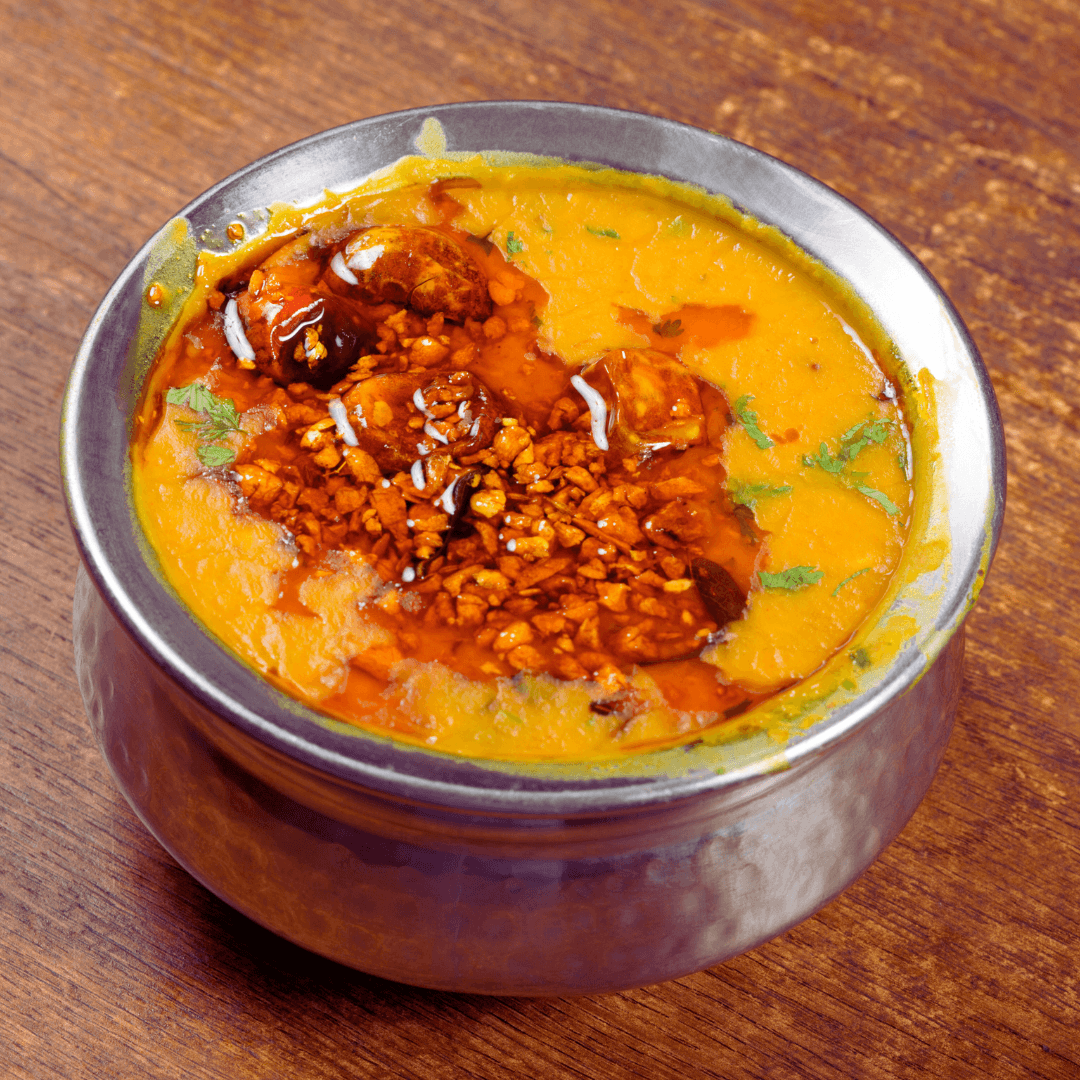
5. Vegan Dal Tadka
Dal Tadka is a comforting and flavourful lentil dish popular in Indian cuisine. It's made of cooked lentils tempered with savoury herbs and spices, making it tasty and wholesome. Dal Tadka is often enjoyed with rice or Indian bread like roti or naan.
Prep time: 10 minutes | Cook time: 30 minutes | Total time: 40 minutes | Servings: 4
Ingredients
- Yellow lentils (moong dal or toor dal): 1 cup, rinsed
- Water: 4 cups
- Oil or vegan butter: 1 tablespoon
- Cumin seeds: 1 teaspoon
- Onion: 1, finely chopped
- Tomatoes: 2, finely chopped
- Garlic: 3 cloves, minced
- Ginger: 1-inch piece, grated
- Green chillies: 2, slit lengthwise (modify to taste)
- Turmeric powder: ½ teaspoon
- Coriander powder: 1 teaspoon
- Red chilli powder: ½ teaspoon (modify to taste)
- Sea salt to taste
- Fresh cilantro for garnish
- Juice of 1 lemon (optional)
Method
- Thoroughly wash the lentils under running water until the water runs clear. Then, put them in a big pot with water. Once the lentils are mushy and cooked, boil them, then lower the heat to a simmer for 20 to 25 minutes.
- Warm the oil or vegan butter in a different skillet over medium heat. When the cumin seeds crackle, their flavour is released.
- Before they get golden brown, add the chopped onions to the pan and sauté them for 5 to 7 minutes.
- Add the grated ginger, minced garlic, and sliced green chillies. After two more minutes of sautéing, the mixture should smell fragrant.
- Add the diced tomatoes to the pan and cook for 5 to 7 minutes or until they break down and soften.
- Sprinkle turmeric powder, coriander powder, red chilli powder, and salt over the onions and tomatoes. Mix well to combine.
- When the spices have tempered, add the cooked lentils to the pan. To mix the flavours, simmer for 5 to 10 minutes while stirring constantly.
- To add a tart flavour, squeeze in one lemon juice if preferred.
- Before serving, garnish with fresh cilantro leaves.
- Serve the dish piping hot alongside rice or Indian bread.
Nutrition Facts Of Vegan Dal Tadka (per serving)
- Calories: 200 kcal
- Protein: 10g
- Fat: 3g
- Carbohydrates: 30g
- Fiber: 8g
- Sugar: 4g
Health Benefits Of Dal Tadka
- Protein, fiber, and vital minerals like iron and folate—which support healthy muscles and blood sugar regulation—are abundant in lentils.
- Aromatic spices like ginger, garlic, and turmeric used in Dal Tadka have anti-inflammatory and immune-boosting properties, promoting overall well-being.
- Dal Tadka is low in fat and cholesterol, making it a heart-healthy option that can help lower the risk of heart disease.
Conclusion
In conclusion, Vegan Recipes of India is an enjoyable exploration of the multifaceted and abundant realm of plant-based Indian cooking.
From aromatic curries to savoury snacks and indulgent desserts, these recipes showcase the vibrant flavours and textures of traditional Indian cooking without using any animal products.
These dishes embrace the principles of compassion, sustainability, and health and celebrate the abundance of plant-based ingredients and India's culinary heritage.
Whether you're a seasoned vegan or simply curious about exploring new flavours, Vegan Recipes of India invites you to discover the delicious possibilities of cruelty-free and environmentally sustainable eating while savouring the essence of India's culinary traditions.
I trust you enjoyed this article about the Authentic Vegan Recipes Of India. Please stay tuned for more blog posts soon. Take care!
JeannetteZ
>>>Please click here to read my Vegan Travel Guides To World Destinations<<<
>>>Want To Learn How To Create Delicious, Cruelty-Free, Healthy AND 100% Vegan Meals? Try These Awesome Vegan Cooking Courses With A Free 7-DAY MEMBERSHIP<<<
Your Opinion Is Important To Me
Do you have thoughts, ideas, or questions? I would love to hear from you. Please leave me your questions, experiences, and remarks about the article Authentic Vegan Recipes Of India in the comments section below. You can also email me at Jeannette@LivingTheVeganLifestyle.org.
Disclosure
This post may contain affiliate links. I earn from qualifying purchases as an Amazon Associate and other affiliate programs. Please read my full disclosure.
Here are links to some of my favourite articles:
Best Vegan Brunch Recipe Ideas
Best Nonmeat Sources Of Vitamin B12
Best Vegan Barbecue Foods For Your Next Cookout
Animal Rights vs Animal Welfare

